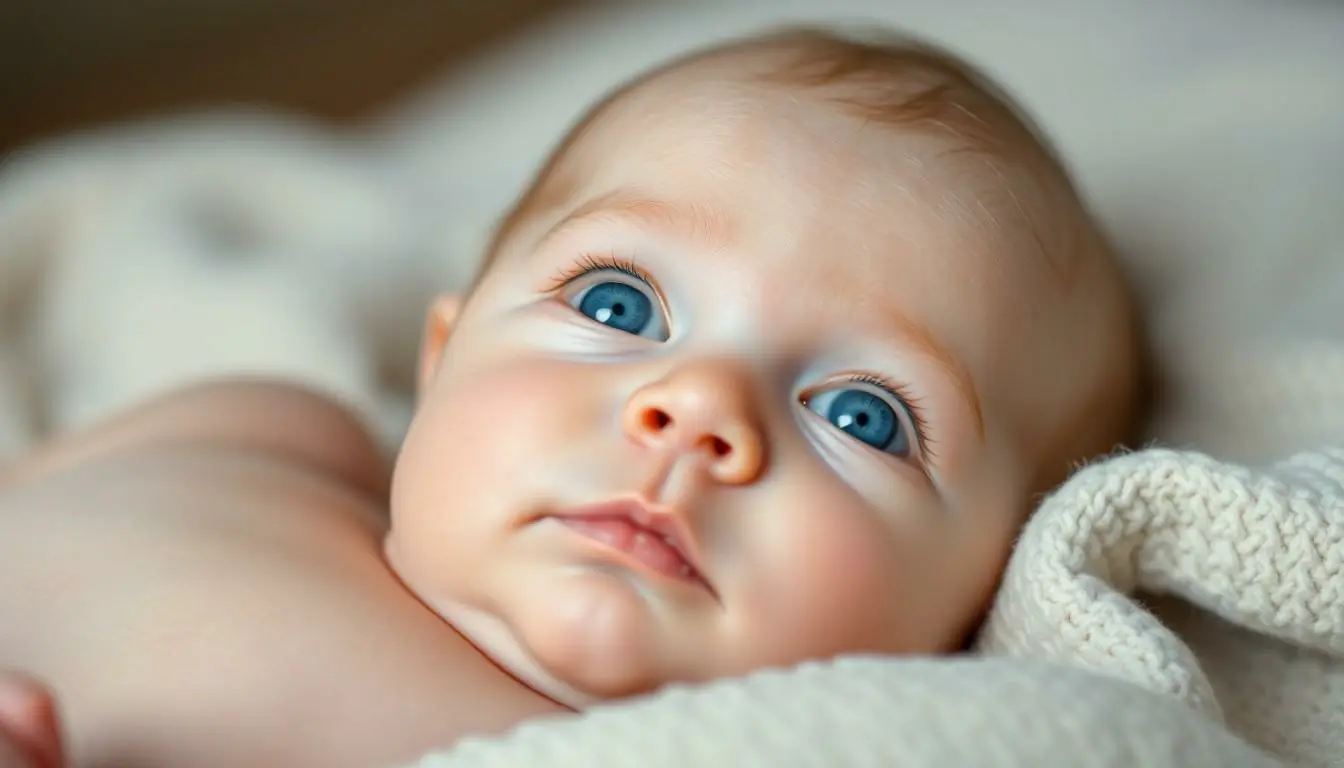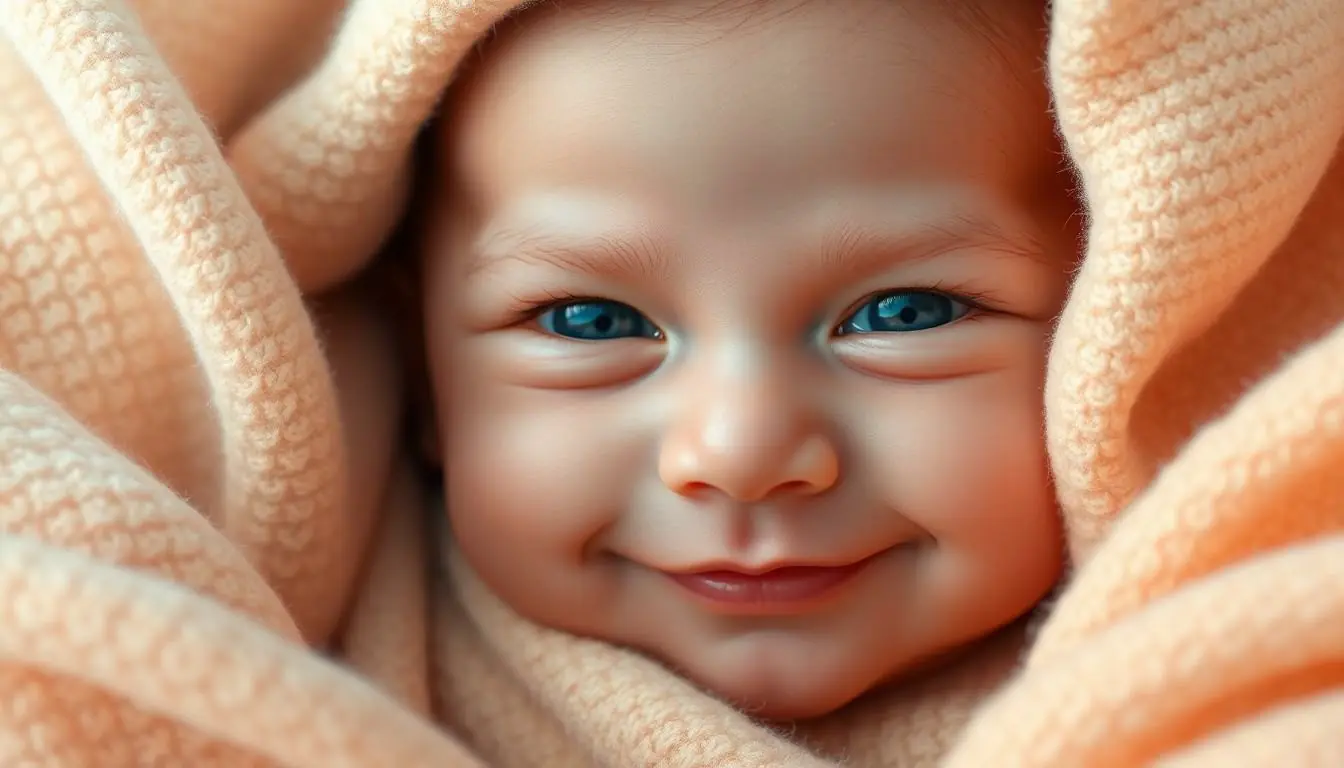Ever gazed into a newborn’s eyes and wondered if you’re looking at a future blue-eyed heartthrob or a brown-eyed genius? The truth is, eye color in infants is like a surprise party waiting to unfold. Most newborns kick off their journey with a shade of blue or gray, but don’t get too attached just yet—those peepers are in for a transformation.
In the first few months, the magic happens. Genetics and melanin levels come together in a dramatic showdown, determining whether those baby blues will stick around or morph into something else entirely. So buckle up, because the eye color rollercoaster is about to begin! Understanding when and how this change occurs will not only satisfy your curiosity but also help you appreciate the unique beauty of your little one’s evolving gaze.
Table of Contents
ToggleUnderstanding Newborn Eye Color
Most newborns exhibit blue or gray eyes at birth. This initial color results from low melanin levels in their irises. Changes in eye color may occur as melanin production increases. By six months, many infants show a noticeable shift.
Genetics plays a crucial role in determining final eye color. Parents’ eye colors influence the likelihood of specific outcomes. A child could inherit genes that lead to brown, green, or hazel eyes. Environmental factors also contribute but genetics remain predominant.
Melanin, the pigment responsible for eye color, increases over time. This gradual change can lead to transformations most evident between three to six months. Factors influencing melanin production include genetics, sunlight exposure, and overall health.
It’s important to understand that not all newborns experience dramatic changes. Some newborns retain their original eye colors into adulthood. Eye color stabilization often occurs around three years of age. By then, most children will have their permanent eye color established.
The journey of eye color is unique to each child. Variations may arise from mixed heritage, leading to unexpected hues. Parents often find joy in observing these changes, celebrating their child’s individuality.
Factors Influencing Eye Color
Newborn eye color changes result from various factors. Genetics and melanin production play significant roles in determining the final hue.
Genetics
Genetics primarily dictates eye color. Each parent contributes genes that influence melanin levels. Specific gene combinations lead to different colors, like brown and blue. For instance, parents with darker eyes often produce children with darker shades due to dominant genes. Additionally, recessive genes can manifest through lighter-colored eyes, highlighting the unpredictability of genetic inheritance. Variability among siblings means each child can have unique eye colors, even within the same family.
Melanin Production
Melanin production significantly impacts eye color changes. At birth, low melanin levels result in blue or gray eyes. As infants grow, melanocytes in the iris increase melanin production, leading to eye color changes. Most noticeable shifts occur by six months when melanin levels increase, changing the shades. Natural light exposure and other environmental factors may also stimulate melanin production, influencing eye coloration. This cumulative effect results in a richer, more definitive eye color as the child matures, often stabilizing around three years of age.
Typical Timeline for Color Change
Newborns experience a notable transformation in eye color, typically influenced by genetics and melanin production. The following sections outline this fascinating journey.
At Birth
At birth, most infants have blue or gray eyes due to low melanin levels. Genetic factors heavily influence this initial coloration. Some newborns might display a darker shade, but it’s less common. The exact hue varies depending on an infant’s genetic background. Observing this initial color provides a glimpse into potential changes ahead.
During the First Few Months
During the first few months, eye color can shift significantly as melanin production increases. Many infants display visible changes around six months. Environmental factors and genetics play crucial roles in this transformation. By this stage, parents often notice a deepening of their baby’s eye color. Each child may exhibit unique variations based on inherited traits from both parents.
By One Year
By one year, eye color stabilizes for many infants. The majority will have shown substantial changes in melanin levels, often resulting in darker hues. Some children may still experience minor adjustments, especially in the second year. This period reveals the lasting influence of genetics on eye color. Parents frequently observe a more defined eye color that reflects family traits.
Variations in Eye Color Change
Newborn eye colors can change significantly over time, leading to a variety of results influenced by genetics and melanin production.
Common Changes
Changes in eye color typically start around six months of age. Most infants born with blue or gray eyes transition to darker shades. Some may shift to green or hazel as melanin levels increase. By one year, eye color often stabilizes, reflecting the predominant shades of family members. Genetic factors play a key role, determining how much melanin is produced. Melanin levels can lead infants to develop brown, green, or hazel eyes, with brown being the most prevalent globally. Each baby’s unique genetic makeup contributes to these common changes.
Uncommon Eye Colors
Rare eye colors can occur in newborns, though they are less frequent. Some infants may exhibit shades such as violet or amber, resulting from specific genetic combinations. Amber eyes arise from a unique concentration of yellowish melanin. A few babies might also possess greenish-gray or slate blue eyes due to a unique interplay of light scattering and melanin. These uncommon colors often fascinate parents and caregivers. Often, they can signal unusual genetic inheritance that adds diversity to eye color.
Conclusion
The journey of a newborn’s eye color is a captivating process shaped by genetics and melanin production. As infants grow, their eye color can shift dramatically within the first year, often settling into hues that reflect their family’s traits. This transformation not only highlights the beauty of genetic diversity but also offers a glimpse into the unique characteristics that each child inherits. Understanding this process helps parents appreciate the fascinating changes their little ones undergo, celebrating the individuality that makes each child special. Embracing these changes can deepen the bond between parents and their children as they witness the evolution of their child’s eye color.





